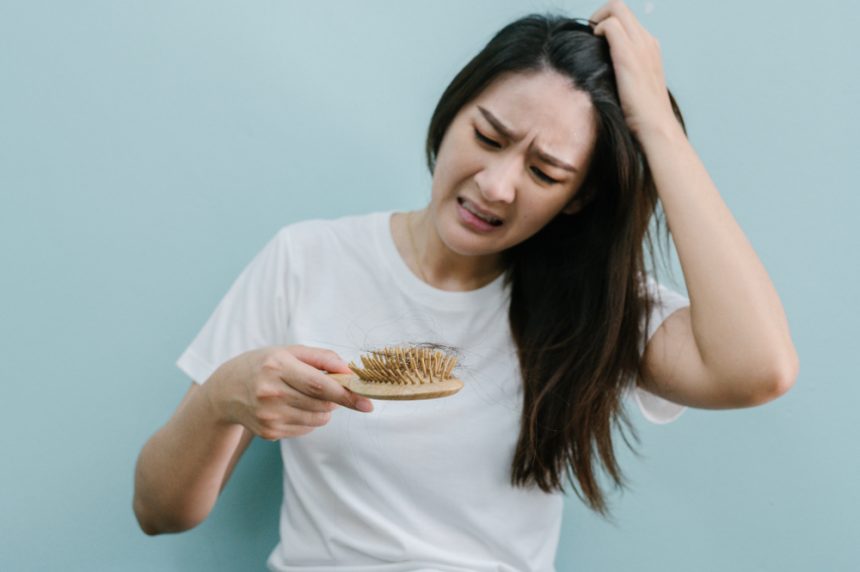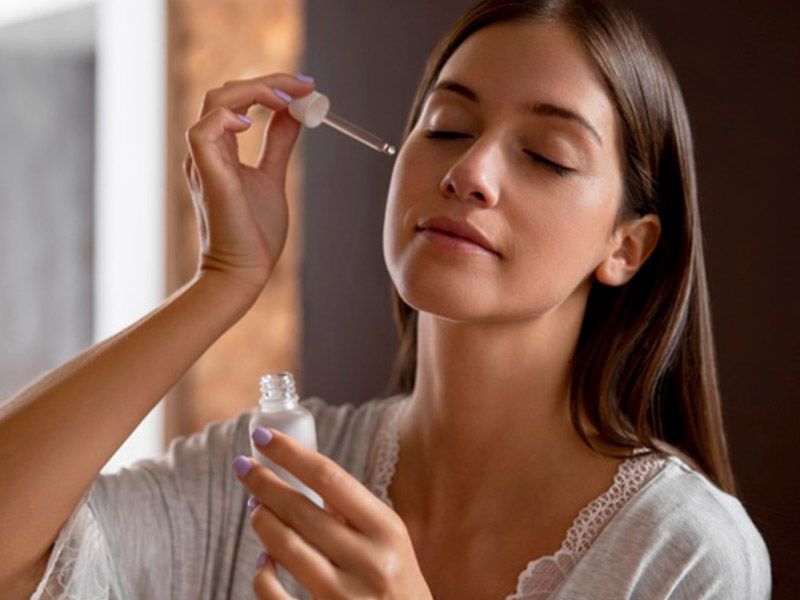Hair fall in women, a distressing concern affecting many individuals, can have a profound impact on self-confidence and emotional well-being. When making treatments for hair loss in women, it’s important to think about the unique problems these people face. This page is about what causes female pattern baldness, what its signs are, and how to treat it. By learning about the causes, solutions, and ways to stop hair loss, women may be able to deal with it better and stop it from happening again. This detailed guide was written with the goal of giving women the information they need to deal with hair loss and get their hair and self-esteem back on track. It looks at all possible reasons, from changes in hormones and diet to genetic risk factors and underlying health problems.
Causes of Hair Fall in Women
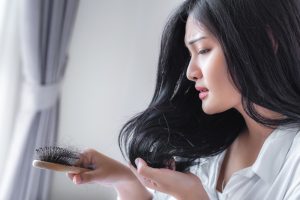
Hair fall in women can be attributed to various underlying factors. Understanding these parts is important for dealing with the problem in the right way and making care plans that work. The following are common factors contributing to hair fall in women:
Hormonal Imbalances:
Hormonal fluctuations play a significant role in hair health. Changes in hormones have a big effect on the quality of hair. When the amounts of estrogen and progesterone change, as they do during pregnancy and after giving birth, hair loss may happen for a short time. Additionally, conditions like polycystic ovary syndrome (PCOS) and thyroid disorders can disrupt hormonal balance and contribute to hair fall in women.
Nutritional Deficiencies:
If you don’t get enough of certain chemicals, it could hurt the health of your hair. If you don’t get enough iron, vitamins (like Biotin, Vitamin D, and Vitamin E), and minerals (like Zinc and Selenium), your hair cells may get weaker and start shedding more.
Genetic Predisposition:
Because hair loss may be caused in part by genetics, it’s important to think about choice C. Androgenetic alopecia, which is another name for female pattern hair loss, is caused by both genetics and hormones. When women have a family history of baldness, they lose more hair.
Underlying Medical Conditions:
Certain medical conditions can contribute to hair fall in women. Autoimmune disorders, like alopecia areata, can cause sudden hair loss in patches. Psoriasis and seborrheic dermatitis are two diseases that can cause redness and itching of the head. This can make hair loss worse.
By recognizing and understanding these causes of hair fall in women, individuals can take proactive steps toward managing and addressing the underlying factors. For efficient management of hair fall in women, it is strongly advised that they seek expert help for diagnosis and individualized treatment strategies.
Solutions for Hair Fall in Women

Addressing hair fall in women requires a comprehensive approach that targets the underlying causes and promotes hair health. Women who use the right treatments may be able to control and stop hair loss. The following are potential solutions for addressing hair fall in women:
Haircare Practices:
A dedication to consistent haircare procedures is necessary to maintain healthy hair. This means gently washing and conditioning the hair using products made for the specific hair type of each individual. By avoiding chemical treatments, tight hairstyles, and severe heat styling, you can reduce breakage and damage to your hair.
Nutritional Interventions:
A healthy body and mind come before healthy hair. Eating foods rich in iron, vitamins (such as Biotin, Vitamin D, and Vitamin E), and minerals (like Zinc and Selenium) may promote hair growth and prevent nutritional deficiencies. To correct certain nutritional deficiencies, medical professionals may prescribe dietary supplements.
Medical Treatments:
A number of medical procedures are available to help women control hair loss. Topical minoxidil promotes hair growth and reduces hair loss; it has been approved by the FDA for treating female pattern hair loss. There are other oral medications that may be used, including finasteride and spironolactone. When concentrated platelets are injected into the head as part of a PRP treatment, it also helps hair grow.
Lifestyle Modifications:
Altering your way of life may help reduce hair loss. Worry-related hair loss may be stopped by using stress management techniques like yoga, meditation, or counseling. Additionally beneficial to overall health and hair health are regular exercise and enough sleep. It has also been discovered that platelet-rich plasma (PRP) therapy, which involves injecting concentrated platelets into the scalp, encourages hair growth.
The maintenance of a regular exercise regimen and obtaining adequate sleep help to promote overall health and hair health. By implementing these habits, women may stop additional hair loss and improve the strength and vitality of their hair. To acquire advice and guidance that is targeted to your unique needs and circumstances, it’s crucial to consult with physicians or dermatologists. With the right approach, women may regain their confidence and maintain healthy, lustrous hair.
Tips for Preventing Hair Fall in Women
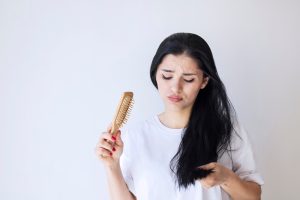
Preventing hair fall in women requires a proactive approach that focuses on maintaining hair health and minimizing potential causes of hair loss. By implementing the following tips, women can promote stronger, fuller hair and reduce the risk of excessive hair fall. Women may prevent excessive hair loss by following these tips:
- A hair-healthy diet should contain vitamins, minerals, and proteins. Eat fruits, vegetables, lean meats, whole grains, and healthy fats.
- Drink enough water every day.
- Use gentle, sulfate-free hair products. Shampooing and harsh towel-drying may harm hair.
- Avoid heat styling equipment like flat irons and curling irons and harsh chemical treatments like perming and relaxing, which may weaken and damage hair.
- Regular haircuts prevent split ends and breakage, supporting healthy hair development.
- Gently massage the scalp with fingers in circular movements for a few minutes to stimulate it. This helps circulation, hair growth, and hair loss.
- Ponytails, braids, and buns may cause strain and breakage.
- To avoid hair breakage, use wide-toothed combs or soft-bristled brushes.
Women may prevent hair loss by following these preventative methods and implementing them into their hair care regimen. Individual outcomes may vary, therefore talking with healthcare experts or dermatologists may give individualized advice and assistance based on requirements and situations.
Seeking Professional Help
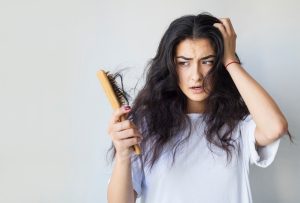
When dealing with persistent or severe hair fall in women, it is crucial to seek professional help. Healthcare experts or specialists in hair health can give help, accurate assessments, and personalized treatment plans. When seeing a professional about hair loss, keep these in mind:
- Hair loss or thinning over a long period of time.
- See a doctor right away if your hair falls out all at once or in patches.
- If you are losing your hair, you may feel better about yourself, your life, and your mental health if you talk to a professional.
- A doctor may do tests, look at your medical history and the medical history of your family, and look at your head and scalp to figure out why you are losing your hair.
- Loss of hair can be caused by problems with hormones, the thyroid, or the immune system.
- To be effective, therapy needs to be both diagnosed and treated.
- Healthcare providers can make specific treatment plans based on the findings and the person’s needs. These plans may include drugs, skin treatments, food advice, changes to the person’s lifestyle, or specialty techniques like PRP.
- See your doctor from time to time to keep track of your progress, ask questions, and have your treatment plan changed.
With professional help, the root causes of hair loss can be found and treated, which makes it easier to deal with and helps hair grow back. Remember that each individual’s situation is unique, and professional guidance is crucial for developing a targeted approach to tackle hair fall in women effectively.
Conclusion
In conclusion, addressing hair fall in women is a multi-faceted journey that requires understanding, proactive measures, and professional guidance. If women are aware of the underlying reasons, such as hormonal issues, nutritional deficits, genetic factors, and underlying medical diseases, they may be able to control and reduce hair loss. Some ways to take care of your hair, changes to your food, medical treatments, and changes to your lifestyle can all lead to better hair and less hair loss. For correct diagnoses and personalized treatment plans, you need help from a professional. By taking these precautions, women can stop their hair loss from getting worse and get their self-esteem back.







